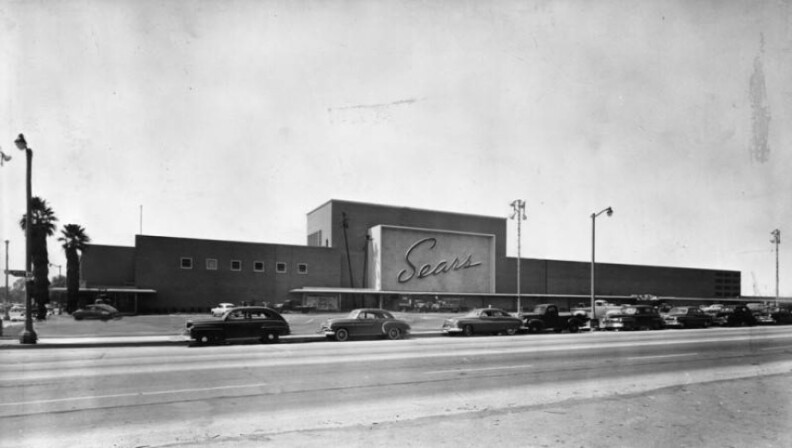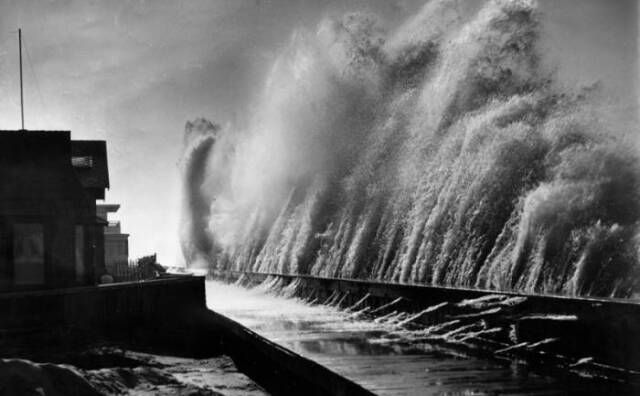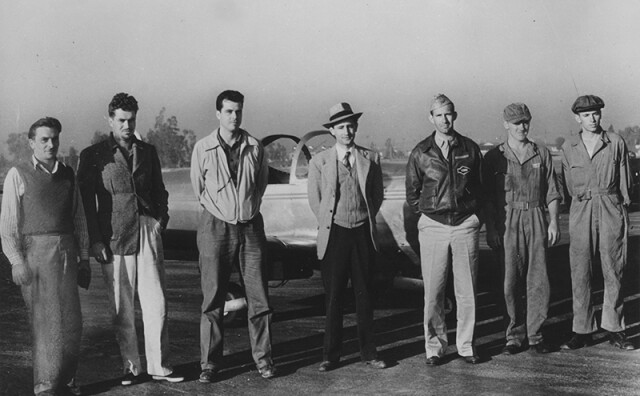Bye, Boyle Heights Sears. What Comes Next For This Art Deco Behemoth?

For Gary Gibson, a trip to the Glendale Sears in the 1960s was an exciting proposition. Much more than a budget department store, the fortress-like building had a locksmith, a shoeshine stand and, in the basement, pinball machines located near the Craftsman lawnmower shed. Every Christmas season, the area was dusted with fake snow to become Santa's living room. Most crucially, Sears had a candy counter.
"The candy counter had giant pieces of chocolate honeycomb, roasted nuts and rocky road, and the smell was amazing," Gibson says. "If we parked in the lower level of the lot, there was a concrete tunnel that led under the alley into the store. This was our favorite entrance because as small children we would shout 'BAH!!!' and there was such a wonderful echo."

Oh, How The Mighty Have Fallen
Greater Los Angeles is home to approximately 20 Sears and Kmart stores. That might sound like a lot but when these two brands merged in 2005, they formed one of the largest retail entities in the world with 3,500 stores around the United States. In the last decade, the company has closed more than 90% of them.
With consumers spending more money online and shifting their allegiance to chains such as Target and Walmart, Sears had little choice but to file for Chapter 11 bankruptcy in 2018. The following year, it closed 96 locations, spelling the end for stores in Crenshaw, North Hollywood, Riverside and West Covina. The Glendale and Torrance stores hung on until early 2020. When the latest round of closures ends, the U.S. will have fewer than 200 Sears locations.

The crumbling of the mighty Sears retail empire has left massive buildings sitting on valuable real estate. In Boyle Heights, at the nine-story, Art Deco complex that started it all, the scene has, for years, been a strange mix of bustling commerce and yawning, empty space.
Located at 2650 East Olympic Boulevard, the imposing Sears flagship, which was added to the National Register of Historic Places in 2006, towers above the surrounding neighborhood like a fortress to capitalism. Inside, the contrast couldn't be more stark. The vast, mostly empty building feels spooky and antiseptic, the merchandise dwarfed by the cavernous space.
Most of the complex has been empty since 1992, when the mail order center closed and hundreds of people lost their jobs. At ground level, the optometrist is closed as is the watchmaker's kiosk, a service from another era. But in one small portion of the building, there is life.

Masked customers can still head to the second floor to scope out the best deals on tools, household appliances and Jaclyn Smith jumpers. The pickings are slim. Everything seems to be on permanent sale in the white, antiseptic store. There are washers and dryers, gold jewelry with diamond flecks and Craftsman coveralls but not in the quantities you'd expect. It's like walking through the consumer version of an Old West ghost town.
The parking lot is livelier, as families purchase tortas, nachos, aguas frescas and ice cream at El Tropical Snack Bar, a colorful food counter near the entrance. Children slurping down on sundaes sit with their parents at the cement picnic tables under striped umbrellas. It's fun and friendly but not quite cheery enough to make you forget the husk of the mail order warehouse with its broken windows looming above.
The building's future is uncertain, according to a recent Los Angeles Times story, "At least three Kmart stores and 10 Sears locations are listed for lease on the website of commercial real estate services firm JLL." That list includes the Sears in Boyle Heights.

The Glory Years
A century ago, the prospect of Sears coming to boomtown Los Angeles was the talk of the Southland.
Sears was one of the most important companies in the country, its meteoric rise made possible by railroads and America's growing working and middle classes. According to historian Teresa Grimes, quoted in a National Register of Historic Places Form:
"Sears, Roebuck & Company was synonymous with the surge in the mass consumer market in America during the early and mid-twentieth century. Richard Sears established the company in 1886 and within a short period of time, the company became one of the largest mail-order businesses in the country and the seventh largest corporation in the world. By 1927, Sears provided goods to eleven million customers, which equaled one out of every three American families, and it distributed over seventy-five million catalogs per year."

On December 25, 1926, Sears presented the city of Los Angeles with a massive gift.
L.A. had become the fifth largest city in the U.S. and established itself as an important center of trade and commerce. According to the Los Angeles Times, on Christmas Day, A.G. Arnoll, general manager of the powerful L.A. Chamber of Commerce, announced that Sears had purchased 8.5 acres of the Hostetter Industrial Tract in Boyle Heights, which connected to the Union Pacific Railway. The company planned to build a massive retail store and mail-order house on the site.

Sears also announced that his company had purchased five acres at Vermont and Slauson avenues, where they'd build another retail store. Three days later, steam shovels began to clear the Boyle Heights site, situated near the Los Angeles River.
Both buildings were designed by George C. Nimmons and Co. of Chicago and supervised by architect George Carr. For the Boyle Heights hub, the firm included a 226-foot tower, which hid a water tank. Made of pressed brick and trimmed with artificial stone, the building was constructed entirely from materials sourced in California.
Construction on the Boyle Heights Sears was completed in only 146 working days. On July 24, 1927, thousands of people showed up for the opening ceremonies. Multi-colored lights illuminated the building as dignitaries explained what the arrival of a company like Sears meant for the city.

The Los Angeles Times says D.F. McGarry, president of the L.A. Chamber of Commerce, gave a particularly stirring speech:
"The mere investment in buildings and equipment's not all there is to be considered in the coming to Los Angeles of this great concern. Vast economic advantages will accrue as the result of the establishment of the company here. First of all, 1800 workers are given employment in the plant at an annual payroll in excess of $2 million. The company also will patronize manufacturers of the local metropolitan area and the entire Southwest, and thus will play an important role in the upbuilding of industry in this territory."

According to journalist Roger Vincent, 100,000 people visited the store in its first month. The Boyle Heights store was an important driver of the local economy, employing approximately 2,000 workers. It was also a source of fascination for residents, who could take a free tour and see the distribution center in action. Long before Amazon lured customers with its one-day delivery, Sears officials boasted their warehouse could send an item within 24-hours of receiving an order form in the mail.

Material World
The Vermont store opened soon after the Boyle Heights one and was a success. Done in the Spanish Revival style, it also included a fortress-like watchtower.
Sears weathered the Great Depression and even expanded thanks to its low prices on practical, essential items and the convenience of shopping through the catalogue. By the end of the 1930s, the number of physical store locations had almost doubled, according to History.

The company's next big investment in L.A. County came during the post-World War II building boom, as thousands of G.I.s returned home and settled in houses begging to be filled with modern appliances.

In 1945, the company announced it would expand the Glendale store and open two new branches, one each in the middle class neighborhoods of Compton and Inglewood. The Compton store would be an impressive, hangar-type structure with a super service station, perfect for L.A.'s expanding car culture. But it was the tenth L.A. County Sears that would inspire the most comment and continuing nostalgia.
In 1947, the Santa Monica Sears opened at 302 Colorado Boulevard. Designed by Rowland H. Crawford in the Streamline Moderne style, the store cost a whopping $300,000 to build. According to the L.A. Conservancy, it was designed to catch the attention of motorists driving to and from the beach. If the urge to shop overcame a passing driver, they could pull into the 200-space parking lot, indulge in some retail therapy and buy a tankful of gas at the service station.
According to the Landmarks Commission of the City of Santa Monica:
"Character-defining features of the Sears Main Building that are indicative of the Late Moderne style include horizontally-patterned corner seriations and elongated window bands, smooth concrete exterior surfaces incised with a grid-like pattern, curving canopies, and stylized decorative bas-relief sculptures."
For Santa Monica, the arrival of Sears was a sign that the once sleepy beach town had come of age.
"It was the largest and most prominent department store in the city of Santa Monica. It's credited with contributing to the economic development of the central business district," says Carol Lemlein, Vice President of the Santa Monica Conservancy Board of Directors.
Frequent Santa Monica Sears shopper Victoria Morrow concurs. "Santa Monica [Sears] is iconic, a real symbol of what the city was like just after the war. So much optimism, so much delight in purchasing after wartime rationing," she says.

For the next six decades, Sears remained a mainstay for many Angelenos. They went to the department store for everything from dishwashers and lawnmowers to back-to-school dresses and engagement rings.
Jean Smith has fond memories of shopping at the Northridge Sears as a child in the 1980s and '90s. "When I was shopping with my dad, we always would go to the basement for tools. My mom only went to the basement to look at appliances with my dad, and otherwise, my mom stayed on the top levels for clothes," Smith says.

Her favorite memory dates to 1993, when The Nightmare Before Christmas came out.
"I loved the movie so much! I wandered away from my mom at Sears and went to the boys clothing section, and they had a whole display of Nightmare Before Christmas stuff. I picked out a sweatshirt I really loved and took it back to the girls' section. I pretended I found the sweatshirt in the girls' section, and my mom believed me and bought it! I later told her the truth -- I am a terrible liar -- and she was so mad! But she let me keep the sweatshirt because she agreed it was a nice sweatshirt and looked good on me," Smith says.
As tastes changed and online shopping lured customers away from brick and mortar stores, the company's decline accelerated. "Over time, it felt less and less like a Sears and more like a store that got its hands on cheaply made stuff," Morrow says.

In 2008, the hulking, windowless Sears on Santa Monica Boulevard in East Hollywood closed its doors. It remains empty, a magnet for homeless folks and taggers. Fights over its future have been waged between its former owners and local groups such as the La Mirada Neighborhood Association, which also opposed construction on the nearby Target (aka the Target Husk) at Sunset Boulevard and Western Avenue.
In 2015, the CIM Group paid $53.5 million for the 5.7-acre East Hollywood site. It hopes to transform it into a mixed-use complex with apartments and storefronts. However, it appears work hasn't started and CIM did not respond to LAist's requests for an interview about the status of the development.
By 2017, most Sears customers had moved on. "I didn't know anyone who really went to Sears anymore," Smith says.

The Boyle Heights mail order center has also had a tortured history since closing in the early '90s. Many different plans for the building have been announced over the years, including one touted by boxer Oscar De La Hoya, who had shopped there as a child.
In 2013, the Shomof Group of Beverly Hills bought the 13-acre complex with plans to turn it into a multi-use community dubbed the "Mail Order District" and designed by trendy architectural firm Omgivning. The website for the luxury project touts a future food court, retail spaces, penthouses, jogging paths and amenities including a "basketball court, putting green, pool and jacuzzi, indoor and outdoor fitness centers, playground, bocce, hammocks, fire pits, cabanas and socializing lounge."

So far, none of that has happened. In fact, construction doesn't appear to have started. "We put everything on hold for the next couple months. We will know more in two months," Isek Shomof said when reached for comment in February 2020.
For Seritage Growth Properties, which manages many of the Sears stores that have closed or are about to, leasing and developing its expanding portfolio of outdated, 20th century stores has been a mixed bag. In an assessment for the Motley Fool, financial analyst Adam Levine-Weinberg says Seritage's "strategy has been to replace Sears and Kmart stores in its portfolio with higher paying tenants." However, the company has had challenges finding businesses willing to pay top dollar, resulting in many empty stores.

Seritage is currently in charge of several former Sears stores in the L.A. area, including the North Hollywood store at Valley Plaza, the Northridge Fashion Center store in Riverside and the Janss Marketplace store in Thousand Oaks.
So far, its most successful L.A. project has been the conversion of the historic Santa Monica Sears into the Mark 302, a multi-use complex with a market hall, beer garden, rooftop garden and office space. Developer Kacy Keys told the Los Angeles Times in 2017 she hoped the building would attract a "Silicon Beach-type tenant." The $50 million renovation, which is well underway, seems to have pulled off a hat trick -- pleasing business leaders and conservationists.
Politicians can tout a shiny new building with all the right amenities while conservationists like that the revamped structure has retained its Art Deco facade and other historic features.
"It's a really interesting design to us because it accomplishes a seismic retrofit as well as making an attractive building for adaptive reuse without altering the exterior significantly," Carole Lemlein, Vice President of the Santa Monica Conservancy, says in a Mark 302 promotional booklet.
As department stores, from fashion-forward Barneys to middlebrow Macy's shut their doors, more large commercial spaces will either need to be demolished or redeveloped.

The former Sears Auto Center in Northridge is going to become a Porto's Bakery. Unibail-Rodamco-Westfield, owners of the former Sears Store in Burbank's Warner Center, have announced that they will turn the 160,000 square-foot complex into an upscale "entertainment center," complete with movie theater, restaurants and bowling alley.
Experience-based businesses are increasingly taking the place of traditional brick-and-mortar store, but for many Angelenos, the thrill of going to Sears was once an experience all by itself.
-
Restored with care, the 120-year-old movie theater is now ready for its closeup.
-
Councilmember Traci Park, who introduced the motion, said if the council failed to act on Friday, the home could be lost as early as the afternoon.
-
Hurricane Hilary is poised to dump several inches of rain on L.A. this weekend. It could also go down in history as the first tropical storm to make landfall here since 1939.
-
Shop owners got 30-day notices to vacate this week but said the new owners reached out to extend that another 30 days. This comes after its weekly swap meet permanently shut down earlier this month.
-
A local history about the extraordinary lives of a generation of female daredevils.
-
LAist's new podcast LA Made: Blood Sweat & Rockets explores the history of Pasadena's Jet Propulsion Lab, co-founder Jack Parsons' interest in the occult and the creepy local lore of Devil's Gate Dam.










